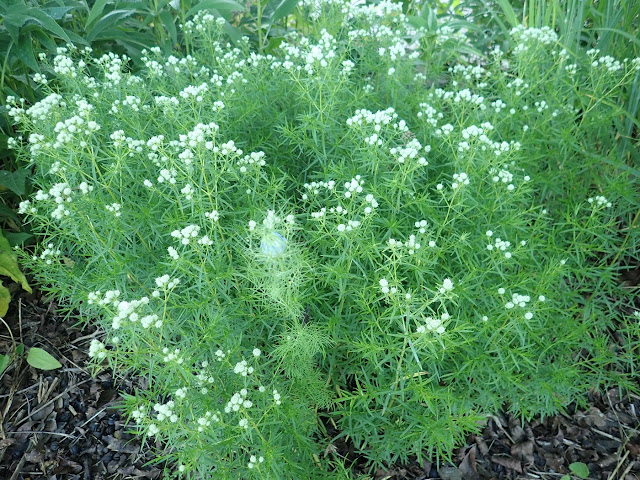Well, here's another beauty - golden groundsel.
There's just one problem, I've ordered and planted two species of golden groundsel (they have the same common name) - Packera aurea and Packera obovata.
And I can't tell them apart in my garden. Or perhaps only one species survived? Don't know. But whichever I've got, it's doing lovely, especially on the shady northern foundation next to an arrowwood viburnum, but also in the far back bed where it gets full sun pretty much all day.
Versatile? You bet.
Beautiful? Yep.
I missed taking a pic of the yellow blooms for this post, but I still got the fluffy seedheads and the lovely foliage.
It's more or less evergreen here, though it can get tattered in a harsh winter like the one we just hand. So far) the old foliage seems to decay naturally and unobtrusively, never building up into an unwieldy mush (as with lamb's ears) or hanging on in a frazzled way (as with say cranesbill geraniums).
The yellow flowers attract little pollinators, and the white seedheads that follow are fluffy and charming. It mostly spreads by underground rhizomes, though occasionally I think I've found a seedling or two nearby to the parent plant. It does tolerate transplantation, although it tends to sulk for a while as it gets established.
In my heavy soil, it has spread by a measured pace so far. You can take a look back at this April 2017 post to see just how much ground it has covered in the last 16 months or so.
I do worry that it will be harder to control in the long run. Where it's relatively easy to uproot Robin's plantain, I tried digging up Packera in a couple places where I thought it was not growing so well only to find that I missed root particles that came back stronger than ever. So consider that a bit of a warning.
On the other hand, I don't think I'd mind having a lot of Packera in my landscape. It's certainly low growing enough that I don't think it would compete with bushes, shrubs or even taller, sturdier, deep-rooted perennials like Baptisia or Solidago. But I'm not sure. It will be interesting to see what happens as it starts to bump up against lawn grasses and/or other groundcovers like Erigeron.
For now, it would be one of my top groundcover suggestions to anyone gardening within the native range of the lovely golden groundsels.





















